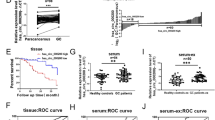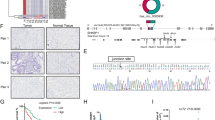Abstract
Gastric cancer is a common malignant tumor, and due to its insidious onset and limited screening methods, most patients are diagnosed with advanced disease and have a poor prognosis. The circRNA in exosomes has an essential role in cancer diagnosis and treatment. However, the part of hsa_circ_0014606 within exosomes in gastric cancer progression is unclear. Firstly, we extracted exosomes from the serum of gastric cancer patients and healthy individuals by ultracentrifugation and analyzed the expression of hsa_circ_0014606 in both exosomes; then knocked down hsa_circ_0014606 in vivo and in vitro, respectively, to observe its effect on the physiological function of gastric cancer cells; finally, we used bioinformatics to screen hsa_circ_0014606 targeting miRNAs and mRNAs, and experiments were performed to verify the interrelationship between the three. The results showed that the level of hsa_circ_0014606 in the serum exosomes of gastric cancer patients was significantly higher than that of the healthy population. The knockdown of hsa_circ_0014606 slowed the proliferation of gastric cancer cells, significantly reduced migration and invasion ability, accelerated apoptosis, and reduced tumor size in mice. In addition, the expression of hsa_circ_0014606 was negatively correlated with the expression of miR-514b-3p and positively correlated with the expression of heterogeneous nuclear ribonucleoprotein C (HNRNPC). In conclusion, hsa_circ_0014606 exerted a pro-cancer effect indirectly through miR-514b-3p targeting gene HNRNPC, and this study provides a new potential target for treating gastric cancer.





Similar content being viewed by others
Data Availability
All datasets used and analyzed during the current study are available from the corresponding author upon reasonable request.
References
Joshi SS, Badgwell BD. Current treatment and recent progress in gastric cancer. CA Cancer J Clin. 2021;71(3):264–279.
Pimentel-Nunes P, Libânio D, Bastiaansen BAJ, et al. Endoscopic submucosal dissection for superficial gastrointestinal lesions: European Society of Gastrointestinal Endoscopy (ESGE) Guideline - Update 2022. Endoscopy. 2022;54(6):591–622.
Lordick F, Carneiro F, Cascinu S, et al. Gastric cancer: ESMO Clinical Practice Guideline for diagnosis, treatment and follow-up. Annals of oncology: official journal of the European Society for Medical Oncology. 2022;33(10):1005–1020.
Li S, Zhang M, Zhang H, et al. Exosomal long noncoding RNA lnc-GNAQ-6:1 may serve as a diagnostic marker for gastric cancer. Clinica chimica acta; international journal of clinical chemistry. 2020;501:252–257.
Ajani JA, D’Amico TA, Bentrem DJ, et al. Gastric Cancer, Version 2.2022, NCCN Clinical Practice Guidelines in Oncology. Journal of the National Comprehensive Cancer Network: JNCCN. 2022;20(2):167–192.
Allum W, Lordick F, Alsina M, et al. ECCO essential requirements for quality cancer care: Oesophageal and gastric cancer. Critical reviews in oncology/hematology. 2018;122:179–193.
Vasconcelos MH, Caires HR, Ābols A, Xavier CPR, Linē A. Extracellular vesicles as a novel source of biomarkers in liquid biopsies for monitoring cancer progression and drug resistance. Drug resistance updates: reviews and commentaries in antimicrobial and anticancer chemotherapy. 2019;47:100647.
Zhang XY, Zhang PY. Gastric cancer: somatic genetics as a guide to therapy. Journal of medical genetics. 2017;54(5):305–312.
Leja M, Linē A. Early detection of gastric cancer beyond endoscopy - new methods. Best practice & research Clinical gastroenterology. 2021;50–51:101731.
Meldolesi J. Exosomes and Ectosomes in Intercellular Communication. Current biology: CB. 2018;28(8):R435-r444.
Kok VC, Yu CC. Cancer-Derived Exosomes: Their Role in Cancer Biology and Biomarker Development. International journal of nanomedicine. 2020;15:8019–8036.
Dai J, Su Y, Zhong S, et al. Exosomes: key players in cancer and potential therapeutic strategy. Signal transduction and targeted therapy. 2020;5(1):145.
Xu Z, Chen Y, Ma L, et al. Role of exosomal non-coding RNAs from tumor cells and tumor-associated macrophages in the tumor microenvironment. Molecular therapy: the journal of the American Society of Gene Therapy. 2022;30(10):3133–3154.
Vahabi A, Rezaie J, Hassanpour M, et al. Tumor Cells-derived exosomal CircRNAs: Novel cancer drivers, molecular mechanisms, and clinical opportunities. Biochemical pharmacology. 2022;200:115038.
Lin Y, Zheng ZH, Wang JX, Zhao Z, Peng TY. Tumor Cell-Derived Exosomal Circ-0072088 Suppresses Migration and Invasion of Hepatic Carcinoma Cells Through Regulating MMP-16. Frontiers in cell and developmental biology. 2021;9:726323.
Rao M, Zhu Y, Qi L, Hu F, Gao P. Circular RNA profiling in plasma exosomes from patients with gastric cancer. Oncology letters. 2020;20(3):2199–2208.
Iwai K, Minamisawa T, Suga K, Yajima Y, Shiba K. Isolation of human salivary extracellular vesicles by iodixanol density gradient ultracentrifugation and their characterizations. Journal of extracellular vesicles. 2016;5:30829.
Zhu L, Sun HT, Wang S, et al. Isolation and characterization of exosomes for cancer research. J Hematol Oncol. 2020;13(1):152.
Kalluri R, LeBleu VS. The biology, function, and biomedical applications of exosomes. Science (New York, NY) 2020;367(6478).
Daßler-Plenker J, Küttner V, Egeblad M. Communication in tiny packages: Exosomes as means of tumor-stroma communication. Biochimica et biophysica acta Reviews on cancer. 2020;1873(2):188340.
Bi Y, Guo X, Zhang M, et al. Bone marrow derived-mesenchymal stem cell improves diabetes-associated fatty liver via mitochondria transformation in mice. Stem Cell Res Ther. 2021;12(1):602.
Liu J, Sun Y, Zhu B, et al. Identification of a potentially novel LncRNA-miRNA-mRNA competing endogenous RNA network in pulmonary arterial hypertension via integrated bioinformatic analysis. Life sciences. 2021;277:119455.
Xiong DD, Dang YW, Lin P, et al. A circRNA-miRNA-mRNA network identification for exploring underlying pathogenesis and therapy strategy of hepatocellular carcinoma. J Transl Med. 2018;16(1):220.
Wang X, Fang L. Advances in circular RNAs and their roles in breast Cancer. Journal of experimental & clinical cancer research: CR. 2018;37(1):206.
Li XN, Wang ZJ, Ye CX, Zhao BC, Li ZL, Yang Y. RNA sequencing reveals the expression profiles of circRNA and indicates that circDDX17 acts as a tumor suppressor in colorectal cancer. Journal of experimental & clinical cancer research: CR. 2018;37(1):325.
Lei B, Tian Z, Fan W, Ni B. Circular RNA: a novel biomarker and therapeutic target for human cancers. International journal of medical sciences. 2019;16(2):292–301.
Ma X, Yan W, Xu P, et al. LncRNA-p21 suppresses cell proliferation and induces apoptosis in gastric cancer by sponging miR-514b-3p and up-regulating ARHGEF9 expression. Biological chemistry. 2022;403(10):945–958.
Ren LL, Yan TT, Shen CQ, et al. The distinct role of strand-specific miR-514b-3p and miR-514b-5p in colorectal cancer metastasis. Cell death & disease. 2018;9(6):687.
Wu C, Wang Z, Tian X, Wang J, Zhang Y, Wu B. Long non-coding RNA DDX11-AS1 promotes esophageal carcinoma cell proliferation and migration through regulating the miR-514b-3p/RBX1 axis. Bioengineered. 2021;12(1):3772–3786.
Yang C, Zang Y, Wu S, et al. Silencing circFTO inhibits malignant phenotype through modulating DUSP4 expression in clear cell renal cell carcinoma. Cell Death Discov. 2022;8(1):392.
Wang LC, Chen SH, Shen XL, et al. M6A RNA Methylation Regulator HNRNPC Contributes to Tumorigenesis and Predicts Prognosis in Glioblastoma Multiforme. Front Oncol. 2020;10:536875.
Zhu W, Wang J, Liu X, et al. lncRNA CYTOR promotes aberrant glycolysis and mitochondrial respiration via HNRNPC-mediated ZEB1 stabilization in oral squamous cell carcinoma. Cell death & disease. 2022;13(8):703.
Wang S, Xu G, Chao F, Zhang C, Han D, Chen G. HNRNPC Promotes Proliferation, Metastasis and Predicts Prognosis in Prostate Cancer. Cancer management and research. 2021;13:7263–7276.
Wu Y, Zhao W, Liu Y, et al. Function of HNRNPC in breast cancer cells by controlling the dsRNA-induced interferon response. The EMBO journal 2018;37(23).
Huang H, Han Y, Zhang C, et al. HNRNPC as a candidate biomarker for chemoresistance in gastric cancer. Tumour biology: the journal of the International Society for Oncodevelopmental Biology and Medicine. 2016;37(3):3527–3534.
Funding
This work was supported by a grant from “1 + X” program for clinical competency enhancement–interdisciplinary innovation project, the Second Hospital of Dalian Medical University (2022JCXKYB02).
Author information
Authors and Affiliations
Contributions
JT, XL, and HH conceived and designed the experiments. JT, XL, QX, LR, and CY performed the experiments and contributed reagents/materials/analysis tools. JT, XL, and HH wrote the paper. All authors have read and approved the manuscript. JT is the first author; XL is the co-first author; HH is the corresponding author.
Corresponding author
Ethics declarations
Ethics approval and consent to participate
All experiments were approved by the Second Hospital of Dalian Medical University, Dalian, China. And all experiments were performed in accordance with relevant guidelines and regulations.
Consent for publication
All authors have read this manuscript and consented for publication.
Competing interests
The authors declare no potential conflict of interest.
Additional information
Publisher’s Note
Springer Nature remains neutral with regard to jurisdictional claims in published maps and institutional affiliations.
Rights and permissions
Springer Nature or its licensor (e.g. a society or other partner) holds exclusive rights to this article under a publishing agreement with the author(s) or other rightsholder(s); author self-archiving of the accepted manuscript version of this article is solely governed by the terms of such publishing agreement and applicable law.
About this article
Cite this article
Jiang, T., Xu, L., Qu, X. et al. Hsa_circ_0014606 Derived from Exosomes Promotes Gastric Carcinoma Tumorigenesis and Proliferation by Sponging miR-514b-3p to Upregulate HNRNPC. Dig Dis Sci 69, 811–820 (2024). https://doi.org/10.1007/s10620-023-08254-z
Received:
Accepted:
Published:
Issue Date:
DOI: https://doi.org/10.1007/s10620-023-08254-z




